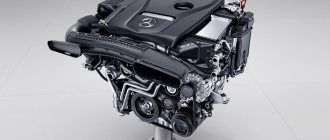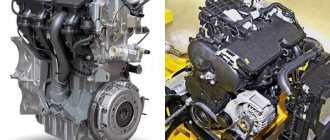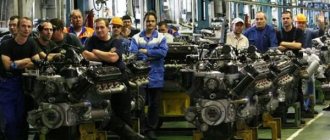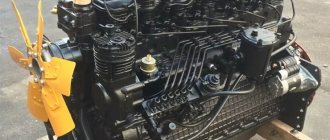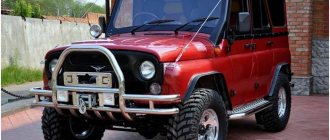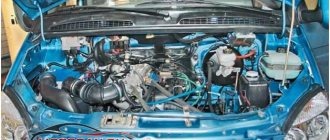In terms of reliability, popularity and prevalence, A-series motors are not inferior to Toyota S-series power drives. The 4A FE engine was created for cars of classes C and D, that is, numerous modifications and restyled versions of Carina, Corona, Caldina, Corolla and Sprinter. Initially, the internal combustion engine does not have complex components and can be repaired and serviced by the owner in the garage without visiting a service station.
In the basic version, the manufacturer provides 115 liters. s., but for some markets it is recommended to artificially reduce the power to 100 hp. With. to reduce transport tax and insurance premiums.
The markings in the Toyota engine are completely informative, although a little encrypted. For example, the presence of 4 cylinders is indicated not by a number, but by the Latin F, the first letter A indicates the engine series. Thus, 4A-FE stands for as follows:
- 4 – the motor was developed fourth in its series;
- A - one letter indicates that it began to leave the factory before 1990;
- F – four-valve engine design, drive on one camshaft, transmission of rotation from it to the second camshaft, no boost;
- E – multi-point injection.
Distributed injection
In other words, the peculiarity of these engines is the “narrow” cylinder head and DOHC gas distribution pattern. Since 1990, power drives have been modernized to convert them to low-octane gasoline. For this purpose, the LeanBurn power system was used, which allows the fuel mixture to be leaner.
LeanBurn system
To get acquainted with the capabilities of the 4A FE motor, its technical characteristics are summarized in the table:
| Manufacturer | Tranjin FAW Engines Plant No.1, North Plant, Deeside Engine Plant, Shimoyama Plant, Kamigo Plant |
| Engine brand | 4A FE |
| Years of production | 1982 – 2002 |
| Volume | 1587 cm3 (1.6 l) |
| Power | 82 kW (110 hp) |
| Torque moment | 145 Nm (at 4400 rpm) |
| Weight | 154 kg |
| Compression ratio | 9,5 – 10,0 |
| Nutrition | injector |
| Motor type | in-line petrol |
| Ignition | mechanical, distributor |
| Number of cylinders | 4 |
| Location of the first cylinder | TVE |
| Number of valves on each cylinder | 4 |
| Cylinder head material | aluminum alloy |
| Intake manifold | duralumin |
| An exhaust manifold | steel welded |
| Camshaft | phase 224/224 |
| Cylinder block material | cast iron |
| Cylinder diameter | 81 mm |
| Pistons | 3 repair sizes, original with counterbore for valves |
| Crankshaft | cast iron |
| Piston stroke | 77 mm |
| Fuel | AI-92/95 |
| Environmental standards | Euro 4 |
| Fuel consumption | highway – 7.9 l/100 km combined cycle 9 l/100 km city – 10.5 l/100 km |
| Oil consumption | 0.6 – 1 l/1000 km |
| What kind of oil to pour into the engine by viscosity | 5W30, 15W40, 10W30, 20W50 |
| Which engine oil is best by manufacturer | BP-5000 |
| Oil for 4A-Fe by composition | Synthetics, semi-synthetics, mineral |
| Engine oil volume | 3 – 3.3 l depending on vehicle |
| Operating temperature | 95° |
| ICE resource | declared 300,000 km actual 350,000 km |
| Adjustment of valves | nuts, washers |
| Cooling system | forced, antifreeze |
| Coolant volume | 5.4 l |
| water pump | GMB GWT-78A 16110-15070, Aisin WPT-018 |
| Spark plugs for RD28T | BCPR5EY from NGK, Champion RC12YC, Bosch FR8DC |
| Spark plug gap | 0.85 mm |
| Timing belt | Belt Timing 13568-19046 |
| Cylinder operating order | 1-3-4-2 |
| Air filter | Mann C311011 |
| Oil filter | Vic-110, Mann W683 |
| Flywheel | 6 bolt mounting |
| Flywheel mounting bolts | M12x1.25 mm, length 26 mm |
| Valve stem seals | Toyota 90913-02090 intake Toyota 90913-02088 exhaust |
| Compression | from 13 bar, difference in adjacent cylinders maximum 1 bar |
| XX speed | 750 – 800 min-1 |
| Tightening force of threaded connections | spark plug – 25 Nm flywheel – 83 Nm clutch bolt – 30 Nm bearing cap – 57 Nm (main) and 39 Nm (rod) cylinder head – three stages 29 Nm, 49 Nm + 90° |
The Toyota manufacturer's operating manual recommends changing the oil after 15,000 km. In practice, this is done twice as often, or at least after 10,000 miles.
Engine history
In Russia and around the world, Japanese cars from the Toyota concern enjoy deserved popularity due to their reliability, excellent technical characteristics and relative affordability. Japanese engines, the heart of the concern's cars, played a significant role in this recognition. For several years, a number of products from the Japanese automaker were equipped with the 4A FE engine, the technical characteristics of which still look good to this day.
Appearance:
Its production began in 1987 and continued for more than 10 years - until 1998. The number 4 in the name indicates the serial number of the engine in the “A” series of Toyota power units. The series itself appeared even earlier, in 1977, when the company's engineers faced the task of creating an economical engine with acceptable technical performance. The development was intended for the B-class car (subcompact according to the American classification) Toyota Tercel.
The result of engineering research was four-cylinder engines with power from 85 to 165 horsepower and volume from 1.4 to 1.8 liters. The units were equipped with a DOHC gas distribution mechanism, a cast iron body and aluminum heads. Their heir was the 4th generation, discussed in this article.
Interesting: The A-series is still produced at the joint venture Tianjin FAW Xiali and Toyota: 8A-FE and 5A-FE engines are produced there.
History of generations:
- 1A – years of production 1978-80;
- 2A - from 1979 to 1989;
- 3A – from 1979 to 1989;
- 4A - from 1980 to 1998.
Specifications 4A-FE
Let's take a closer look at the engine markings:
- number 4 - indicates the number in the series, as mentioned above;
- A – engine series index, indicating that it was developed and began production before 1990;
- F – talks about technical details: four-cylinder, 16-valve unboosted engine driven by a single camshaft;
- E – indicates the presence of a multi-point fuel injection system.
In 1990, the power units in the series were modernized to enable operation on low-octane gasoline. For this purpose, a special power system for leaning the mixture, LeadBurn, was introduced into the design.
System illustration:
Let us now consider what characteristics the 4A FE engine has. Basic engine data:
| Parameter | Meaning |
| Volume | 1.6 l. |
| Developed power | 110 hp |
| Engine weight | 154 kg. |
| Engine compression ratio | 9.5-10 |
| Number of cylinders | 4 |
| Location | Row |
| Fuel supply | Injector |
| Ignition | Distributor |
| Valves per cylinder | 4 |
| BC building | Cast iron |
| Cylinder head material | Aluminium alloy |
| Fuel | Unleaded gasoline 92, 95 |
| Environmental Compliance | Euro 4 |
| Consumption | 7.9 l. – on the highway, 10.5 – in city mode. |
Engine Toyota 4A FE 1.6 l/110 l. With.
In terms of reliability, popularity and prevalence, A-series motors are not inferior to Toyota S-series power drives. The 4A FE engine was created for cars of classes C and D, that is, numerous modifications and restyled versions of Carina, Corona, Caldina, Corolla and Sprinter. Initially, the internal combustion engine does not have complex components and can be repaired and serviced by the owner in the garage without visiting a service station.
In the basic version, the manufacturer provides 115 liters. s., but for some markets it is recommended to artificially reduce the power to 100 hp. With. to reduce transport tax and insurance premiums.
Device Features
Design features of 4A FE:
- in-line cylinders, bored directly into the cylinder block itself without the use of liners;
- gas distribution - DOHC, with two overhead camshafts, controlled by 16 valves;
- one camshaft is driven by a belt, the second camshaft receives torque from the first through a gear;
- the injection phases of the air-fuel mixture are regulated by the VVTi clutch; the valve control uses a design without hydraulic compensators;
- the ignition is distributed from one coil by a distributor (but there is a later modification of the LB, where there were two coils - one for each pair of cylinders);
- the model with the LB index, designed to work with low-octane fuel, has reduced power and reduced torque to 105 horsepower.
Interesting: if the timing belt breaks, the engine does not bend the valves, which adds to its reliability and attractiveness from the consumer.
Design Features
In its series, the 4A FE engine has average performance and has the following design features:
- in-line arrangement of 4 cylinders, bored directly into the body of a cast-iron block without liners;
- two overhead camshafts according to the DOHC scheme to control gas distribution through 16 valves inside the aluminum cylinder head;
- drive one camshaft by a belt, transmitting rotation from it to the second camshaft by a gear;
- distributor ignition distribution from one coil, with the exception of later LB versions, in which each pair of cylinders had its own coil according to the DIS-2 scheme;
- engine options for low-octane LB fuel have less power and torque - 105 hp. With. and 139 Nm., respectively.
The engine does not bend the valves, like the entire A series, so there is no need to do major repairs in the event of a sudden timing belt break.
Version history 4A-FE
During its life cycle, the motor went through several stages of development:
Gen 1 (first generation) - from 1987 to 1993.
- Engine with electronic injection, power from 100 to 102 horsepower.
Gen 2 – rolled off production lines from 1993 to 1998.
- The power varied from 100 to 110 horsepower, the connecting rod and piston group and injection were changed, and the configuration of the intake manifold was changed. The cylinder head was also modified to work with new camshafts, and the valve cover received fins.
Gen 3 – produced in limited quantities from 1997 to 2001, exclusively for the Japanese market.
- This engine had increased power to 115 “horses”, achieved by changing the geometry of the intake and exhaust manifolds.
Pros and cons of the 4A-FE engine
The main advantage of the 4A-FE is its successful design, in which, in the event of a timing belt break, the piston does not bend the valve, avoiding expensive overhauls. Other benefits include:
- availability of spare parts and their availability;
- relatively low operating costs;
- good resource;
- the engine can be repaired and serviced independently, since the design is quite simple, and attachments do not interfere with access to various elements;
- The VVTi clutch and crankshaft are very reliable.
Interesting: when production of the Toyota Carina E began in the UK in 1994, the first 4A FE internal combustion engines were equipped with a control unit from Bosh, which had flexible settings. This became a lure for tuners because the engine could be re-tuned to extract more power while reducing emissions.
The main disadvantage is considered to be the above-mentioned LeadBurn system. Despite the obvious efficiency (which led to the widespread use of LB in the Japanese car market), it is extremely sensitive to the quality of gasoline and in Russian conditions demonstrates a serious drawdown in power at medium speeds. The condition of other components is also important - armored wires, spark plugs, and the quality of the engine oil is critical.
Review of faults and methods for repairing them
Due to its design features, the 4A FE motor is susceptible to the following “diseases”:
| Knock inside the engine | 1) with high mileage, wear of the piston pins 2) with a slight violation of the thermal clearances of the valves | 1) replacing fingers 2) adjusting gaps |
| Increased oil consumption | production of valve stem seals or rings | diagnostics and replacement of consumables |
| The engine starts and stalls | fuel system malfunction | cleaning injectors, distributor, fuel pump, replacing the fuel filter |
| Floating speed | clogging of crankcase ventilation, throttle valve, injectors, wear of the IAC | cleaning and replacing spark plugs, injectors, idle air control |
| Increased vibration | clogged injectors or spark plugs | replacing injectors, spark plugs |
Gaps with idle speed and engine start occur after the sensors have exhausted their service life or are damaged. Due to a burnt-out lambda probe, fuel consumption may increase and carbon deposits may form on the spark plugs. Some Toyota cars were equipped with engines with the Lean Burn system. Owners can fill with gasoline with a low octane number, but the turnaround time is reduced by 30 - 50%.
Where was the 4A FE placed?
The engine was equipped exclusively with Toyota cars:
- Carina – modifications of the 5th generation 1988-1992 (sedan in the T170 body, before and after restyling), 6th generation 1992-1996 in the T190 body;
- Celica – 5th generation coupe in 1989-1993 (T180 body);
- Corolla for the European and US markets in various trim levels from 1987 to 1997, for Japan - from 1989 to 2001;
- Corolla Ceres generation 1 – from 1992 to 1999;
- Corolla FX – generation 3 hatchback;
- Corolla Spacio – 1st generation minivan in the 110th body from 1997 to 2001;
- Corolla Levin - from 1991 to 2000, in E100 bodies;
- Corona – generations 9, 10 from 1987 to 1996, T190 and T170 bodies;
- Sprinter Trueno - from 1991 to 2000;
- Sprinter Marino - from 1992 to 1997;
- Sprinter – from 1989 to 2000, in different bodies;
- Premio sedan – from 1996 to 2001, T210 body;
- Caldina;
- Avensis;
- MR2.
List of car models in which it was installed
Initially, the 4A FE engine was created exclusively for cars of the Japanese manufacturer Toyota:
- Carina – V generation in the T170 sedan body 1988 – 1990 and 1990 – 1992 (restyling), VI generation in the T190 sedan body 1992 – 1994 and 1994 – 1996 (restyling);
- Celica – V generation in the T180 coupe body 1989 – 1991 and 1991 – 1993 (restyling);
- Corolla (European market) - VI generation in the E90 hatchback and station wagon body 1987 - 1992, VII generation in the E100 hatchback, sedan and station wagon body 1991 - 1997, VIII generation in the E110 station wagon body, hatchback and sedan 1997 - 2001;
- Corolla (Japanese domestic market) - 6th, 7th and 8th generation in E90, E100 and E110 sedan/station wagon bodies 1989 - 2001, respectively;
- Corolla (American market) - 6th and 7th generation in E90 and E100 station wagon, coupe and sedan bodies 1988 - 1997, respectively;
- Corolla Ceres – 1st generation E100 sedan 1992 – 1994 and 1994 – 1999 (restyling);
- Corolla FX – III generation in E10 hatchback body;
- Corolla Levin – 6th and 7th generation in E100 and E100 coupe bodies 1991 – 2000;
- Corolla Spacio – 1st generation in the E110 minivan body 1997 – 1999 and 1999 – 2001 (restyling);
- Corona - IX and X generations in T170 and T190 sedan bodies 1987 - 1992 and 1992 - 1996, respectively;
- Sprinter Trueno - 6th and 7th generation in E100 and E110 coupe bodies 1991 - 1995 and 1995 - 2000, respectively;
- Sprinter Marino – 1st generation in the E100 sedan body 1992 – 1994 and 1994 – 1997 (restyling);
- Sprinter Carib – II and III generations in E90 and E110 station wagon bodies 1988 – 1990 and 1995 – 2002, respectively;
- Sprinter – 6th, 7th and 8th generations in AE91, U100 and E110 sedan bodies 1989 – 1991, 1991 – 1995 and 1995 – 2000, respectively;
- Premio – I generation in the T210 sedan body 1996 – 1997 and 1997 – 2001 (restyling).
This engine was installed in Toyota AE86, Caldina, Avensis and MR2; the characteristics of the engine allowed it to be equipped with Geo Prizm, Chevrolet Nova and Elfin Type 3 Clubman cars.
Other engines in the series
4A
The basic model that replaced the 3A series. The engines created on its basis were equipped with SOHC and DOHC mechanisms, up to 20 valves, and the “fork” of output power ranged from 70 to 168 forces on the “charged” turbocharged GZE.
4A-GE
This is a 1.6-liter engine, structurally similar to the FE. The characteristics of the 4A GE engine are also largely identical. But there are also differences:
- GE has a larger angle between the intake and exhaust valves - 50 degrees, in contrast to 22.3 for FE;
- The camshafts of the 4A GE engine are rotated by a single timing belt.
Speaking about the technical characteristics of the 4A GE engine, we cannot mention the power: it is slightly more powerful than the FE and develops up to 128 hp with equal volumes.
Interesting: a 20-valve 4A-GE was also produced, with an updated cylinder head and 5 valves per cylinder. It developed power up to 160 forces.
4A-FHE
This is an analogue of the FE with a modified intake, camshafts and a number of additional settings. They gave the engine greater performance.
4A-GZE
This unit is a modification of the sixteen-valve GE, equipped with a mechanical air pressurization system. 4A-GZE was produced in 1986-1995. The cylinder block and cylinder head have not undergone any changes; an air supercharger driven by the crankshaft has been added to the design. The first samples produced a pressure of 0.6 bar, and the engine developed power up to 145 horsepower.
In addition to supercharging, engineers reduced the compression ratio and introduced forged, convex pistons into the design.
In 1990, the 4A GZE engine was updated and began to develop power up to 168-170 horsepower. The compression ratio has increased, and the geometry of the intake manifold has changed. The supercharger produced a pressure of 0.7 bar, and the MAP D-Jetronic mass air flow sensor was included in the engine design.
The GZE is popular with tuners because it allows the installation of a compressor and other modifications without major engine conversions.
4A-F
It was the carburetor predecessor of the FE and developed up to 95 horsepower.
4A GEU
The 4A-GEU engine, a subtype of GE, developed power up to 130 horsepower. Motors with this marking were developed before 1988.
Technical specifications 4A GE 1.6 l/115 – 240 l. With.
Engine 417 injector technical specifications
Initially, the GE engine of the 4A family had a combustion chamber volume of 1.6 liters and an angle of 50 degrees between the valves. This made it possible to increase power and ensure high performance. The ratio of cylinder diameter to piston stroke is constant for the entire series, 81/77 mm.
In the first generation 4A GE, the engine design was tailored for rear-wheel drive AE86 cars of the Corolla Levin and Sprinter Trueno variants from Toyota. The transverse installation of internal combustion engines for front-wheel drive sports models of Toyota began to be used later, with the advent of the MR2 sports car, and in 1991, Corolla in North America at factories in Canada and the USA of Toyota Corporation ceased to be equipped with 4A GE power units.
Engine 4A-GE Silver Top under the hood
4A-GE
Technical characteristics of 4A GE correspond to the table values below:
| Manufacturer | GM DAT |
| Engine brand | 4A GE |
| Years of production | 1983 – 1998 |
| Volume | 1598 cm3 (1.6 l) |
| Power | 84.6 – 118 kW (124 – 160 hp) |
| Torque moment | 153 Nm (at 4200 rpm) |
| Weight | 112 – 130 kg |
| Compression ratio | 9,4 – 11 |
| Nutrition | injector |
| Motor type | in-line petrol |
| Ignition | distributor |
| Number of cylinders | 4 |
| Location of the first cylinder | TVE |
| Number of valves on each cylinder | 4/5 |
| Cylinder head material | aluminum alloy |
| Intake manifold | duralumin/4 throttles |
| An exhaust manifold | cast iron |
| Camshaft | original cam profile |
| Cylinder block material | cast iron |
| Cylinder diameter | 81 mm |
| Pistons | high skirt |
| Crankshaft | cast iron |
| Piston stroke | 77 mm |
| Fuel | AI-95 |
| Environmental standards | Euro-3 |
| Fuel consumption | highway – 4 – 5 l/100 km mixed cycle 5 – 7 l/100 km city – 8 – 10 l/100 km |
| Oil consumption | 0.2 – 0.6 l/1000 km |
| What kind of oil to pour into the engine by viscosity | 5W30, 5W40, 0W30, 0W40 |
| Which engine oil is best by manufacturer | Liqui Moly, LukOil, Mannol, Toyota, Castrol |
| Oil for 4A GE by composition | synthetics, semi-synthetics |
| Engine oil volume | 3 – 3.7 l depending on the car |
| Operating temperature | 95° |
| ICE resource | declared 250,000 km actual 350,000 km |
| Adjustment of valves | hydraulic compensators |
| Cooling system | forced, antifreeze |
| Coolant volume | 6 l |
| water pump | Toyota 16110-19205, GMB GWT-83A, Aisin WPT-018 |
| Spark plugs for 4A GE | BKR6EP-11 from NGK |
| Spark plug gap | 1.1 mm |
| Timing belt | Gates 5124, Contitech CT527 |
| Cylinder operating order | 1-3-4-2 |
| Air filter | Fram CA5466, Febi 27270, Champion U677/606, Bosch 1457433958, Blue Print ADT32239, Alco MD-9932, Toyota 17801-15070 |
| Oil filter | Mann W68/3, Jakoparts J1312010, Champion C138/606, Bosch 0986452028, Blue Print ADT32109, Alco SP-991, Vic C-110, Toyota 90915-10001 |
| Flywheel | 8 bolt holes, with clutch bore diameter 212 mm |
| Flywheel mounting bolts | M12x1.25 mm, length 26 mm |
| Valve stem seals | manufacturer Goetze |
| Compression | from 13 bar, difference in adjacent cylinders maximum 1 bar |
| XX speed | 750 – 800 min-1 |
| Tightening force of threaded connections | spark plug – 25 Nm flywheel – 102 Nm clutch bolt – 64 Nm bearing cap – 77 Nm (main) and 55 Nm (connecting rod) cylinder head – three stages 20 Nm, 64 Nm + 90° |
